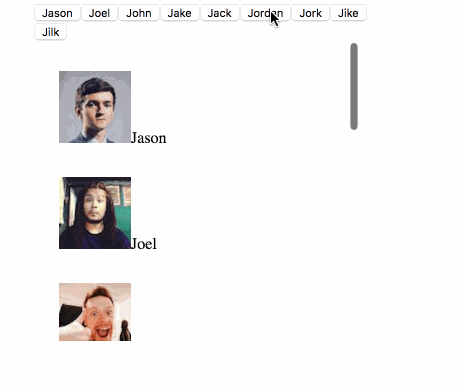Build a Reusable Scroll List Component with Animated scrollTo in React

Intro
It is common in applications to have a scrollable list of content. Depending on other interactions you may want to programmatically scroll to a specific list item. This can occur throughout many areas in your application, and re-building this for everything is unnecessary.
Additionally we don't want our reusable component to add any additional markup. The reason being that some people have very specific styling and adding additional markup may effect that styling.
What are we building? Well something like this. Don't mind the ugly styling, this just a non-styled demo. We'll primarily focus on building this out as a reusable component.

Setup
We're going to start by setting a scrollable list. We have some random data containing images and a name.
This will require some CSS. Our CSS will have an app class. This will just constrain our application to a specific width and center it.
The important class is the scroller class. We have a height, and overflow: auto. Whenever the inner content of the div with scroller grows beyond the visible height it will add a scrollbar. In our case anytime our content is more than 300px it will add the scrollbar.
.app { width: 350px; margin: 0 auto; } .scroller { margin: 0 auto; height: 300px; width: 300px; overflow: auto; } .item { margin: 30px 0; }
Our starting application code will just be a few divs, with our items being mapped over and rendering our items.
import React, { Component } from "react"; import "./App.css"; import items from "./data"; class App extends Component { render() { return ( <div className="app"> <div className="scroller"> {items.map(({ name, image }) => { return ( <div className="item"> <img src={image} /> {name} </div> ); })} </div> </div> ); } } export default App;

Making the ScrollView
To avoid adding additional markup we'll just return this.props.children, and use React.Children.only. When using React.Children.only it will throw an error when attempting to pass in multiple children.
import React, { Component } from "react"; import PropTypes from "prop-types"; class ScrollView extends Component { render() { return React.Children.only(this.props.children); } }
Because we'll use context we'll need PropTypes. They have since been deprecated from the core of React and moved into a separate package called prop-types.
So we'll need to run npm install prop-types. Then import it into our file.
import React, { Component } from "react"; import PropTypes from "prop-types";
Now we'll setup our child context. We have to specify the type of data we are passing down and React will verify that the correct data types are being passed.
class ScrollView extends Component { static childContextTypes = { scroll: PropTypes.object, }; render() { return React.Children.only(this.props.children); } }
Now that we are specifying a scroll context for our children to use. We will setup register and unregister functions to pass down on our scroll object.
Our register will take a name and ref to a component that we can scroll to. Then our unregister will be called to remove an element when an item is removed from a list.
Finally we need to setup getChildContext to define the context for our child elements to get access to.
class ScrollView extends Component { static childContextTypes = { scroll: PropTypes.object, }; register = (name, ref) => { this.elements[name] = ref; }; unregister = (name) => { delete this.elements[name]; }; getChildContext() { return { scroll: { register: this.register, unregister: this.unregister, }, }; } render() { return React.Children.only(this.props.children); } }
Now we're going to need to make a ScrollElement component to register itself with our ScrollView.
Making our ScrollElement
Once again because we don't want to add additional markup we'll use the React.cloneElement call. This will allow us to clone an element and add additional properties onto it.
In our case we need to add the ref prop. This will allow us to eventually get access to the DOM node so that we can scroll to it.
We use the callback ref style of ref because this will allow multiple refs to be used if there are multiple clone elements called, or if a ref is defined on the component.
class ScrollElement extends Component { render() { return React.cloneElement(this.props.children, { ref: (ref) => (this._element = ref), }); } }
Next up we need to grab the scroll object we defined on context. We won't use childContextTypes, we need to use contextTypes this time.
Now in our componentDidMount we will call our register function with the this._element ref and also this.props.name which is defined by the application using the library we're building.
Finally when the component is unmounting we'll call unregister with the name.
class ScrollElement extends Component { static contextTypes = { scroll: PropTypes.object, }; componentDidMount() { this.context.scroll.register(this.props.name, this._element); } componentWillUnmount() { this.context.scroll.unregister(this.props.name); } render() { return React.cloneElement(this.props.children, { ref: (ref) => (this._element = ref), }); } }
Scrolling
You may be moving from a jQuery implementation, and might want to be getting rid of a dependency. To avoid using jQuery or reimplementing the logic of an animated scroll we can use the library.scroll-into-view.
It has 0 dependencies besides raf to help polyfill requestAnimationFrame for older browsers.
We will need to add the scrollTo method onto our `ScrollView.
Because we are using React.cloneElement we don't know if our child is a div or if it's a custom component. Since it could be a custom component we need to use findDOMNode from react-dom to be able to get access to the actual DOM node.
Then we pass it into our scrollIntoView and it will scroll to the element over 500ms and we set the align: { top: 0 } so that it will scroll to the top of the element we are passing in.
import React, { Component } from "react"; import { findDOMNode } from "react-dom"; import scrollIntoView from "scroll-into-view"; import PropTypes from "prop-types";
scrollTo = (name) => { const node = findDOMNode(this.elements[name]); scrollIntoView(node, { time: 500, align: { top: 0, }, }); };
Using Our Elements
We will wrap our div with the scroller class in our ScrollView.
We'll add a ref like <ScrollView ref={scroller => this._scroller = scroller}> so that we can get access to the scrollTo function that we wrote.
Each of our items needs to be wrapped in our ScrollElement and then pass in a name or any other identifying information that we can use to call our scrollTo later.
{ items.map(({ name, image }) => { return ( <ScrollElement name={name}> <div className="item"> <img src={image} /> {name} </div> </ScrollElement> ); }); }
To test out our demo we'll insert some buttons and setup a function to call scrollTo on our _scroller ref.
scrollTo = (name) => { this._scroller.scrollTo(name); };
{ items.map(({ name }) => ( <button onClick={() => this.scrollTo(name)}>{name}</button> )); }
As you can see here onClick will call scrollTo on our App which will then call the scrollTo on our ScrollView component. This will then trigger our animated scroll.
Our app code looks like this.
import React, { Component } from "react"; import "./App.css"; import ScrollView, { ScrollElement } from "./scroller"; import items from "./data"; class App extends Component { scrollTo = (name) => { this._scroller.scrollTo(name); }; render() { return ( <div className="app"> {items.map(({ name }) => ( <button onClick={() => this.scrollTo(name)}>{name}</button> ))} <ScrollView ref={(scroller) => (this._scroller = scroller)}> <div className="scroller"> {items.map(({ name, image }) => { return ( <ScrollElement name={name}> <div className="item"> <img src={image} /> {name} </div> </ScrollElement> ); })} </div> </ScrollView> </div> ); } } export default App;
What it looks like in use

Ending
This isn't robust but you can see how to use context to pass information from a top level wrapping component to children component and build out a library. Using context means none of our implementation is being leaked to the application code.
Code
import React, { Component } from "react"; import { findDOMNode } from "react-dom"; import scrollIntoView from "scroll-into-view"; import PropTypes from "prop-types"; class ScrollView extends Component { static childContextTypes = { scroll: PropTypes.object, }; elements = {}; register = (name, ref) => { this.elements[name] = ref; }; unregister = (name) => { delete this.elements[name]; }; getChildContext() { return { scroll: { register: this.register, unregister: this.unregister, }, }; } scrollTo = (name) => { const node = findDOMNode(this.elements[name]); scrollIntoView(node, { time: 500, align: { top: 0, }, }); }; render() { return React.Children.only(this.props.children); } } class ScrollElement extends Component { static contextTypes = { scroll: PropTypes.object, }; componentDidMount() { this.context.scroll.register(this.props.name, this._element); } componentWillUnmount() { this.context.scroll.unregister(this.props.name); } render() { return React.cloneElement(this.props.children, { ref: (ref) => (this._element = ref), }); } } export { ScrollElement }; export default ScrollView;